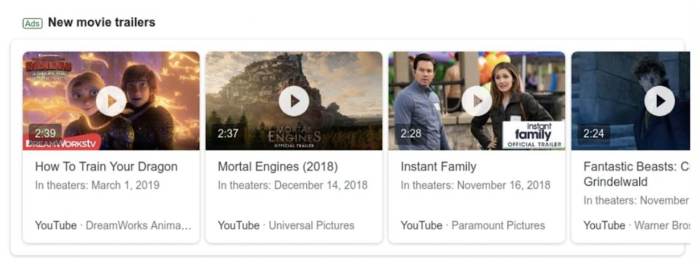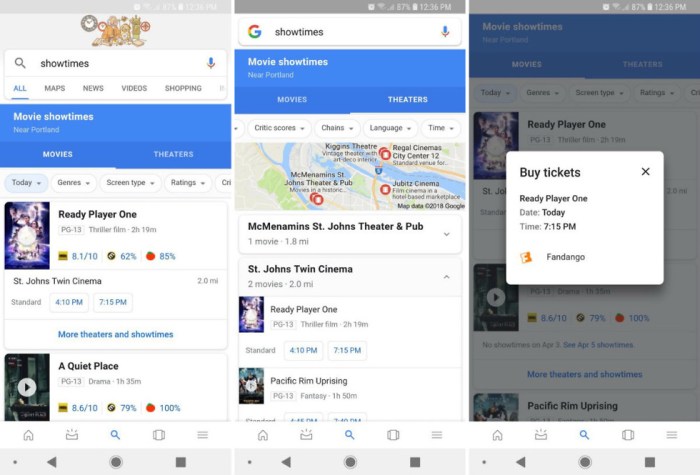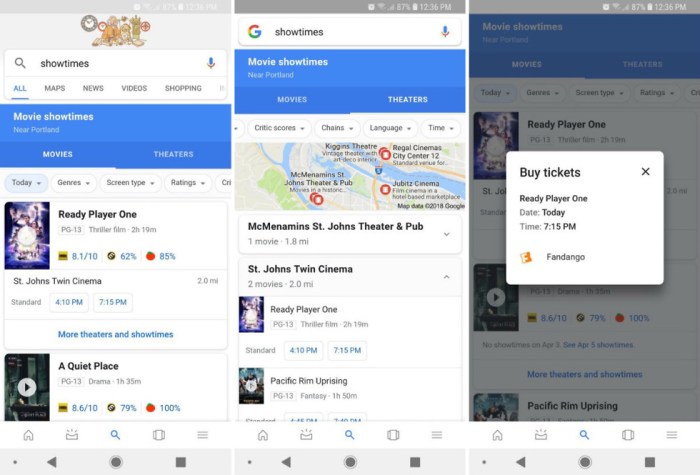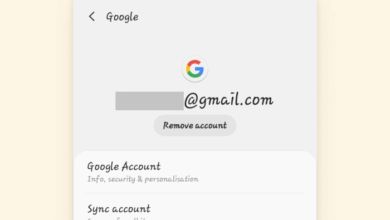Google Goes to the Movies A Deep Dive
Google Goes to the Movies: This exploration delves into Google’s multifaceted involvement in the movie industry, from its current role in production and distribution to its potential impact on the future of moviegoing. We’ll examine how Google’s technology is reshaping the entire movie experience, from discovering films to watching them at home or in theaters.
Google’s influence extends to search, streaming, and even accessibility. This analysis explores how Google’s products and services are affecting movie marketing, promotion, and the overall movie-watching experience. We’ll also look at the potential challenges and benefits of Google’s involvement in this dynamic industry.
Google’s Movie Industry Presence
Google’s influence on the movie industry is multifaceted and profound, extending far beyond simple search results. From facilitating movie discovery and consumption to impacting production and distribution, Google’s technology is deeply woven into the modern cinematic experience. This exploration delves into Google’s current role, examining its various products and services, and highlighting its partnerships with the industry.Google’s presence in the movie world is not just about providing access to films; it’s about enhancing every stage of the movie lifecycle.
Its technological prowess has significantly altered how movies are created, shared, and enjoyed, making it a key player in the evolution of the industry.
Google’s Products and Services Related to Films
Google’s movie-related products and services are extensive and demonstrate a commitment to diverse aspects of the industry. From simple search functions to complex tools for filmmakers, Google provides a range of services to meet different needs. These tools are vital in helping streamline movie-related tasks, making the entire process more efficient.
- Google Search: A fundamental tool for moviegoers, Google Search allows users to easily find information about movies, including trailers, cast lists, plot summaries, and reviews. This simple function significantly aids in the initial stages of movie discovery, and is an essential part of the movie experience.
- YouTube: YouTube’s role in the movie industry is enormous. It provides a platform for studios to showcase trailers, behind-the-scenes footage, and even full-length films, significantly expanding distribution channels. It also allows fans to connect with each other and share their opinions about movies, generating buzz and fostering communities.
- Google Play Movies & TV: Google Play Movies & TV allows users to rent or buy movies and TV shows directly through the platform. This creates a convenient and accessible way for consumers to enjoy films without needing to visit physical retailers.
- Google Cloud Platform (GCP): This powerful platform offers cloud computing services to movie production companies. These services can help streamline workflows, improve collaboration, and enhance storage and retrieval capabilities. GCP provides the tools to facilitate the technical side of filmmaking.
Impact on Movie Production, Distribution, and Consumption
Google’s technology significantly impacts every aspect of the movie industry. From production to distribution to consumption, Google’s services streamline processes, enhance efficiency, and empower individuals.
- Production: Google Cloud Platform (GCP) provides tools for filmmakers to collaborate remotely, store large files, and manage projects efficiently. This facilitates the use of cloud-based software for editing, sound design, and visual effects.
- Distribution: Google’s services like YouTube and Google Play provide alternative distribution channels, reaching audiences globally and increasing access to films. This significantly impacts revenue generation and expands the reach of filmmakers.
- Consumption: Google Search and YouTube allow audiences to easily discover and access movies. Streaming services integrated with Google’s ecosystem further simplify the movie consumption experience.
Google’s Partnerships with the Movie Industry
Google has formed strategic partnerships with various movie studios, actors, and directors, demonstrating its commitment to supporting the industry. These collaborations demonstrate Google’s understanding of the need for collaborative efforts in the film industry.
- Studio Partnerships: Google frequently collaborates with major movie studios, allowing for promotional opportunities and integration of Google products into film production and distribution processes. Examples include promotional tie-ins on movie trailers and releases on Google Play.
- Director and Actor Collaborations: While specific partnerships may not always be publicly announced, Google’s technology is often used by individual filmmakers, allowing them to leverage Google’s tools for their projects.
Comparison with Other Tech Companies
Comparing Google’s involvement with other tech companies in the movie industry reveals its comprehensive approach. While other tech companies focus on specific aspects like streaming or search, Google’s footprint is broader, impacting all stages of the movie lifecycle.
- Netflix: Netflix primarily focuses on streaming, while Google provides a wider range of tools, impacting both the production and consumption of films.
- Amazon: Amazon, like Netflix, is heavily involved in streaming but also offers services like cloud computing, which are less directly involved in the movie-making process compared to Google’s broader approach.
Google’s Movie-Related Products
This table Artikels various Google products related to the movie industry and their functionalities.
| Product | Functionality |
|---|---|
| Google Search | Enables users to find information about movies, including trailers, cast lists, and reviews. |
| YouTube | Provides a platform for movie studios to showcase trailers and full-length films, reaching a wider audience. |
| Google Play Movies & TV | Allows users to rent or purchase movies and TV shows directly. |
| Google Cloud Platform (GCP) | Offers cloud computing services for movie production companies, facilitating collaboration and storage. |
Google’s Potential Impact on Movie Experiences
Google’s pervasive influence extends beyond search and into the entertainment sphere. Its advanced technologies, particularly in artificial intelligence and machine learning, hold immense potential to revolutionize the moviegoing experience, both in theaters and at home. This transformative potential is driven by Google’s commitment to user-centric innovation and its vast data resources.Google’s foray into movie experiences promises personalized enhancements, fostering a more immersive and accessible cinematic journey for audiences of all types.
From refining recommendations to creating interactive elements, the potential applications are vast and varied, promising a future where movies are tailored to individual preferences and needs.
Personalized Movie Recommendations
Tailored recommendations are already a common feature in streaming services. Google’s sophisticated algorithms, capable of analyzing vast amounts of data, can go beyond basic preferences to anticipate and recommend movies aligned with specific moods, genres, or even current events. For instance, a user experiencing a particularly stressful week might receive recommendations for feel-good comedies, while someone interested in a specific historical period might be presented with documentaries or films related to that era.
This personalized approach can lead to a more engaging and satisfying movie-watching experience, encouraging exploration beyond the user’s initial comfort zone.
Interactive Movie Experiences
Imagine a movie theater where viewers can interact with the film in real-time, adjusting aspects like character dialogue or plot points. Google’s AI can power such interactive experiences, allowing users to customize their movie-watching journey based on their reactions and preferences. Furthermore, these interactive experiences can be tailored to cater to different learning styles, allowing viewers to understand the film on a deeper level.
This innovative approach has the potential to enhance the educational value of movies.
Google’s foray into the movie industry is fascinating, but it’s also interesting to consider how advancements in tech infrastructure are impacting the entertainment world. China’s launch of the world’s largest next-gen internet network china starts up worlds biggest next gen internet network will likely accelerate the streaming experience and potentially influence how Google approaches its movie projects.
Ultimately, these interconnected technological developments will shape the future of entertainment, making the whole “Google goes to the movies” thing even more intriguing.
Improved Accessibility
Google’s commitment to accessibility is well-documented. This commitment extends to the movie industry, with potential applications like subtitles in multiple languages, real-time captioning, and audio descriptions for visually impaired viewers. AI-powered tools can improve the quality and accuracy of these features, ensuring a more inclusive and engaging movie experience for everyone. For example, real-time transcription of dialogue can be synchronized with subtitles, ensuring accurate and seamless viewing for deaf or hard-of-hearing individuals.
Google’s foray into the movie industry is fascinating, but it also highlights a growing problem. Companies are increasingly reliant on mobile devices for everything, which creates a significant security challenge. For instance, consider the sensitive data potentially handled on those devices used by Google in their movie production process, from script editing to location scouting. This is further complicated by the security risks that come with these devices, as detailed in this insightful article about mobile devices create security challenge for companies.
Ultimately, Google’s movie ambitions need to consider robust security measures to protect both their data and their reputation.
Innovative Technologies for Movie Theaters and Homes
Several innovative technologies are already being developed and could be implemented in movie theaters and homes, significantly enhancing the viewing experience. For instance, augmented reality overlays could provide additional information about characters, locations, or historical context, enriching the viewer’s understanding of the movie. At home, interactive games and simulations based on the movie could be offered, creating a more immersive experience for families and individuals.
Potential Benefits for Different Demographics
| Demographic | Potential Benefit |
|---|---|
| Children | Interactive elements and educational features can make movies more engaging and informative for younger audiences. |
| Adults | Personalized recommendations can help discover new films aligned with specific interests, moods, or current events. |
| Seniors | Accessibility features, like large font sizes and audio descriptions, can make movies more enjoyable and accessible. |
| People with Disabilities | Real-time captioning, audio descriptions, and interactive features can enhance inclusivity and accessibility. |
Potential Challenges and Drawbacks
While the potential of Google’s technology is substantial, certain challenges and drawbacks need consideration. Maintaining data privacy and security is paramount, especially with the increasing amount of personal data collected and analyzed. Also, the potential for algorithm bias and the impact on traditional movie-making processes are important factors to consider. Furthermore, the financial implications of integrating these technologies into the movie industry, from theaters to streaming platforms, need careful assessment.
The Future of Google in Movies

Google’s foray into the movie industry isn’t just about search results or streaming recommendations; it’s about reshaping the entire cinematic landscape. From AI-powered storytelling tools to innovative distribution models, Google’s influence promises a future where movies are created, consumed, and experienced in unprecedented ways. This evolution isn’t just about technology; it’s about fundamentally changing the creative process and the economics of filmmaking.Google’s existing infrastructure, coupled with its relentless pursuit of technological advancement, positions it to become a pivotal player in the future of movie production and distribution.
This isn’t simply about providing more services; it’s about transforming the industry by offering tools and platforms that were previously unimaginable. The potential for disruption is immense.
Google’s AI-Powered Moviemaking Tools
Google’s AI prowess has the potential to significantly transform the creative process in filmmaking. Imagine AI tools assisting screenwriters in generating plot Artikels, dialogue, or even entire scenes. This doesn’t mean replacing human creativity; instead, it empowers filmmakers with new avenues for exploration and innovation. Google’s algorithms could analyze existing successful films to identify common patterns and suggest fresh ideas.
This could lead to a new era of creative collaboration between humans and artificial intelligence, ultimately pushing the boundaries of storytelling.
Potential Evolution of Google’s Movie Products and Services
Google’s movie-related services are likely to evolve significantly. We can anticipate the integration of AI-driven tools within Google’s existing platforms, such as Google Workspace, for collaborative scripting, editing, and even virtual production. Furthermore, we can anticipate the development of a more comprehensive ecosystem for independent filmmakers, providing tools, resources, and potentially even funding opportunities. This evolution could also extend to the creation of immersive viewing experiences, potentially leveraging VR and AR technologies to transport viewers into the heart of the movie action.
New Business Models and Revenue Streams
Google’s involvement in the movie industry is poised to generate innovative business models and revenue streams. Beyond advertising and subscriptions, Google might explore partnerships with film studios, distributors, and even independent creators for specialized tools or services. This could manifest as subscription tiers offering access to exclusive AI-powered tools or revenue sharing models for filmmakers who leverage Google’s platforms.
Potential revenue streams also include licensing agreements for AI technologies, creating a new market for creative tools and services.
Key Trends Impacting the Movie Industry and Google’s Responses
The movie industry is undergoing a period of rapid transformation. The rise of streaming services, the demand for personalized content, and the increasing popularity of immersive experiences are just a few of the key trends impacting the future of movies. Google is well-positioned to address these challenges.
- Rise of Streaming Services: Google could leverage its cloud infrastructure and streaming expertise to offer competitive streaming services, potentially integrating with its existing YouTube platform or developing a new dedicated platform. This could also include providing innovative features like AI-powered recommendations tailored to individual viewing preferences.
- Demand for Personalized Content: Google’s AI algorithms can be instrumental in creating highly personalized movie experiences, including recommendations, tailored content suggestions, and even interactive elements within streaming platforms.
- Popularity of Immersive Experiences: Google could develop platforms that facilitate the creation and consumption of immersive movies, potentially leveraging VR/AR technologies, or integrating them into existing streaming services. This could lead to a more interactive and engaging movie-watching experience.
- Increased Competition: Google can compete effectively with existing platforms by offering innovative features and services, focusing on ease of use and providing value to filmmakers and viewers.
The Movie-Watching Experience Through Google’s Lens

Google’s pervasive influence on our daily lives extends seamlessly into the movie-watching experience. From discovering new films to streaming them on various devices, Google’s products and services are reshaping how we consume cinematic content. This evolution is driven by the company’s commitment to user-friendly interfaces, powerful search capabilities, and a vast network of interconnected platforms. The future of movie-watching promises an even more integrated and personalized experience, tailored to individual preferences and habits.Google’s multifaceted approach to the movie industry affects every stage of the movie-watching journey.
From initial discovery through streaming and interaction, Google products play a critical role in shaping the modern cinematic experience. The availability of countless movie titles, reviews, and trailers through Google Search, YouTube, and other platforms significantly impacts how people engage with film. This constant evolution of the movie-watching experience underscores Google’s influence on the industry.
Google Search and Movie Discovery
Google Search acts as a central hub for movie discovery. Users can readily access information about upcoming releases, critically acclaimed films, and hidden gems. Advanced search features allow for filtering by genre, director, actors, and even specific themes, facilitating personalized movie searches. This ease of access has dramatically altered how audiences discover and research films before making viewing decisions.
The detailed information available, including trailers, plot summaries, and user reviews, allows for a comprehensive understanding of the film before committing to viewing it. This approach empowers users to make informed decisions and increases their engagement with movies.
Streaming Platforms and Movie Consumption
Google’s YouTube and Google Play Movies platforms are fundamental to modern movie consumption. YouTube’s vast library of trailers, behind-the-scenes footage, and user-generated content provides an immersive experience before a film’s release. Simultaneously, Google Play Movies offers a curated selection of films and TV shows, readily accessible on various devices. This accessibility and the variety of options offered across platforms significantly impact movie consumption habits.
Users can watch trailers on YouTube, browse film reviews on Google Search, and stream the movie on Google Play Movies, all within a seamless ecosystem.
Google’s Movie Delivery Ecosystem
| Platform | Content Delivery Method | Target Audience |
|---|---|---|
| Google Search | Information aggregation, movie listings, trailers | General moviegoers, potential viewers |
| YouTube | Trailers, behind-the-scenes, reviews, user-generated content | Film enthusiasts, potential viewers, existing audiences |
| Google Play Movies | Streaming of movies and TV shows | Consumers seeking a convenient and readily accessible movie viewing experience |
| Google Assistant/Smart Displays | Voice-activated movie search and streaming | Convenience-oriented users |
This table highlights the diversity of platforms Google utilizes to deliver movie content, encompassing information discovery, promotional material, and streaming access. Each platform targets a specific segment of the audience, contributing to a comprehensive movie-watching experience. The evolution of these platforms continues to shape how people interact with movies.
Future of the Movie-Watching Experience
The future of movie-watching, shaped by Google’s technological advancements, is likely to become more personalized and integrated. Imagine a scenario where Google’s AI anticipates your viewing preferences, suggesting movies tailored to your taste based on your past searches, viewing history, and even social media interactions. This personalized approach could revolutionize how movies are discovered and consumed. Furthermore, the seamless integration of movie-related information across Google’s platforms, combined with enhanced accessibility on various devices, promises a richer and more user-friendly experience.
The seamless integration of Google’s services with smart home devices, like smart TVs and speakers, further amplifies the personalized movie-watching experience.
Google’s Influence on Movie Marketing and Promotion
Google has become an indispensable tool for movie studios, transforming how films are marketed and promoted. From initial awareness to final box office receipts, Google’s multifaceted platform plays a crucial role, influencing everything from trailer views to critical reviews. This influence is deeply intertwined with Google’s algorithms, search results, and the vast ecosystem of tools available to filmmakers.Google’s presence in the movie marketing landscape is not simply a supplementary tool; it’s a primary driver in shaping the visibility and success of a film.
The platform’s sophisticated algorithms dictate the reach and prominence of marketing campaigns, ultimately impacting the overall success of a movie. From targeted advertising to comprehensive search results, Google’s influence extends throughout the entire lifecycle of a film’s promotion.
Google’s Role in Advertising and Promotion
Google’s advertising network is a powerful tool for movie studios. Targeted advertising campaigns on YouTube, Search, and other Google platforms allow studios to precisely reach potential audiences based on demographics, interests, and viewing history. This precision targeting maximizes the impact of marketing efforts, ensuring that promotional content is seen by individuals most likely to be interested in the film.
The ability to track and measure the performance of these campaigns provides invaluable data for optimizing future strategies.
Impact of Google’s Algorithms on Movie Visibility, Google goes to the movies
Google’s search algorithms significantly influence a film’s visibility. Search results are often influenced by factors such as user search queries, popularity, and reviews. A film with strong organic search visibility, boosted by positive reviews and high levels of audience engagement, will often rank higher in search results. This organic visibility, in turn, drives greater interest and viewership, creating a positive feedback loop.
Consequently, studios often optimize their marketing strategies to leverage these algorithms for maximum reach and impact.
Influence of Search Results on Movie Popularity
Search results directly affect the perceived popularity of a film. Positive reviews, trailers, and articles appearing prominently in search results can significantly increase a film’s visibility. Conversely, negative feedback or lack of visibility in search results can dampen interest and potentially affect box office projections. Studios carefully monitor and respond to the information appearing in Google search results, actively working to shape public perception.
Examples of Google Tools Used by Movie Studios
Movie studios utilize various Google tools to promote their films. YouTube is a crucial platform for showcasing trailers and behind-the-scenes content, allowing direct engagement with potential audiences. Google Ads is used for targeted advertising campaigns, reaching specific demographics and interests. Google Trends is a useful tool for identifying emerging interests and adjusting marketing strategies to align with current audience preferences.
Furthermore, Google Analytics provides valuable data on campaign performance, enabling studios to measure the effectiveness of different promotional strategies.
Google’s Methods for Tracking Movie Performance
Google offers various tools to track the performance of a film and audience engagement. Google Analytics provides detailed data on website traffic, engagement with trailers, and responses to promotional campaigns. The platform allows for real-time monitoring of key metrics, enabling studios to react quickly to changing trends and adjust their strategies accordingly. YouTube analytics provide insights into trailer views, audience interaction, and overall video performance.
Moreover, Google Search Console helps monitor the visibility and performance of a film’s website in search results, offering valuable data about search queries, rankings, and traffic sources.
The Role of Google in Movie Accessibility: Google Goes To The Movies
Google’s influence extends beyond search and browsing, encompassing a commitment to inclusivity and accessibility. This commitment is crucial in the movie industry, where diverse audiences deserve to enjoy cinematic experiences without barriers. Google’s technology and resources can play a vital role in bridging these gaps, making movies more accessible to individuals with disabilities.Google’s potential to reshape the movie-watching experience for people with disabilities is significant.
By leveraging its vast technological capabilities, Google can create and support assistive technologies that enhance the viewing experience for a wider range of audiences. This involves developing features that go beyond basic captioning and audio description, enabling a more comprehensive and immersive experience for everyone.
Assistive Technologies for Moviegoers
Google’s influence on the movie industry’s accessibility features can be profound. The company could develop or support various assistive technologies. Real-time captioning and translation tools, integrated into streaming platforms or movie theaters, are vital. This allows individuals with hearing impairments to follow the dialogue without relying on separate captioning systems. Further enhancements could include automated audio descriptions for visual impairments.
These descriptions would provide detailed auditory information about the action, characters, and setting, enabling individuals with visual impairments to fully participate in the movie experience. Interactive subtitles that allow users to customize display options and translations, or provide contextual information about characters and settings, are additional potential features. Real-time translation options for different languages are also crucial to enhance the movie experience for international audiences.
Existing Google Initiatives for Accessibility
Google is already involved in enhancing accessibility in various ways. Google Translate is already used for real-time translation in different settings, including educational contexts and other digital environments. Similarly, Google’s captioning tools are readily available and used by many content creators and distributors. This existing infrastructure and expertise can be leveraged to develop tailored solutions for the movie industry.
Google’s foray into the movie business is fascinating, but to truly understand the digital landscape, you need to dig deep to get the truth about file sharing. This in-depth look reveals the complexities of sharing data online, which ultimately impacts how we consume and distribute movies and other content. Google’s ambitions in the movie world are certainly interesting, but understanding the bigger picture of file sharing is crucial.
Furthermore, Google’s involvement in accessibility initiatives demonstrates a commitment to inclusivity.
Potential Challenges in Integrating Accessibility Features
Integrating accessibility features into movie experiences presents challenges. The complexity of real-time translation and captioning, especially for nuanced dialogue and complex plots, needs careful consideration. Maintaining high-quality audio descriptions while not over-explaining or altering the pacing of the movie is essential. Technical compatibility across various movie formats and platforms requires significant coordination. The cost of implementing and maintaining these technologies across different platforms and production methods might pose a significant financial barrier.
Finally, gaining industry-wide adoption and ensuring user-friendliness of these accessibility features is critical.
Summary Table of Existing and Potential Google Accessibility Features
| Feature | Description | Status |
|---|---|---|
| Real-time Captioning | Automatic captioning and translation during movie playback. | Existing in some form; can be enhanced for movies. |
| Automated Audio Description | Detailed auditory information about visual elements for visual impairments. | Potential future development. |
| Interactive Subtitles | Customization of subtitle display and options for context and translation. | Potential future development. |
| Real-time Multilingual Translation | Simultaneous translation of dialogue into multiple languages. | Existing in other contexts; can be adapted for movies. |
Google’s Impact on Movie Production and Distribution
Google’s influence extends far beyond search and advertising. Its suite of technologies is increasingly integrated into the entire movie lifecycle, from initial concept to final viewing. This impact is particularly evident in production and distribution, streamlining workflows and reaching audiences globally. From collaborative tools to innovative distribution models, Google’s footprint is undeniable.
Google’s Technology in Movie Production
Google’s cloud-based tools offer filmmakers a powerful platform for collaboration and streamlined workflows. Document sharing, project management, and communication tools are vital in the often-complex and geographically dispersed movie production process. This facilitates seamless communication and information sharing, reducing delays and improving efficiency.
- Pre-production: Google Docs, Sheets, and Slides allow for collaborative scriptwriting, budgeting, and scheduling. Real-time editing and feedback loops are facilitated, allowing teams to work together efficiently, regardless of location.
- Production: Google’s video editing tools can be used for quick edits and reviews during filming. This facilitates adjustments and improvements in real-time. Moreover, Google Meet and other video conferencing platforms are essential for remote communication with crew members and actors.
- Post-production: Google’s cloud storage solutions can store and manage massive amounts of footage and assets. This ensures secure and readily accessible data for editing, color grading, and special effects work. Tools like Google Photos and similar services can assist in organizing and managing large volumes of images, allowing for better workflow management.
Google’s Tools for Movie Distribution
Google’s vast network and infrastructure provide a powerful platform for reaching global audiences. This encompasses a variety of distribution channels, leveraging existing platforms to reach consumers worldwide.
- Streaming Platforms: Google’s YouTube, with its vast reach, is a crucial platform for filmmakers to distribute their content. YouTube’s features like monetization options and analytics allow filmmakers to track performance and optimize strategies. This accessibility is crucial for independent filmmakers and smaller studios looking to connect with a large audience.
- Google Play Movies: This platform allows for the distribution of movies directly to consumers through Google’s Play Store. This provides another avenue for reaching viewers.
- Partnerships and APIs: Google collaborates with various platforms and distributors. APIs allow for seamless integration, providing a streamlined experience for users across various devices.
Comparative Analysis of Movie Distribution Methods
| Distribution Method | Google’s Involvement | Description |
|---|---|---|
| Traditional Theatrical Release | Limited, primarily through promotion and marketing tools | Movies are released in cinemas. Google plays a supporting role through advertisements and promotions. |
| Digital Streaming (e.g., Netflix, Amazon Prime) | Significant, via YouTube, Google Play, and partnerships | Movies are distributed directly to consumers through streaming platforms. Google’s tools and services are increasingly integral to these platforms’ operations. |
| Direct-to-Consumer Platforms (e.g., YouTube) | Extensive, through YouTube’s features and tools | Independent filmmakers and smaller studios utilize YouTube to distribute content directly. Google’s platform and monetization options provide vital support. |
Examples of Google Tools Used by Filmmakers
Filmmakers use various Google tools to enhance different stages of movie production.
- Google Drive: Collaboration on scripts, budgets, and schedules.
- Google Meet: Virtual meetings with cast and crew.
- Google Sheets: Tracking expenses and managing budgets.
- YouTube: Promoting trailers and releasing films directly to audiences.
Conclusion
In conclusion, Google’s foray into the movie industry is significant, potentially revolutionizing how we discover, consume, and experience films. From personalized recommendations to enhanced accessibility features, Google’s technology is poised to transform the entire movie-watching landscape. The future of cinema is intertwined with Google’s innovative spirit, and this exploration has only scratched the surface of this fascinating intersection.







